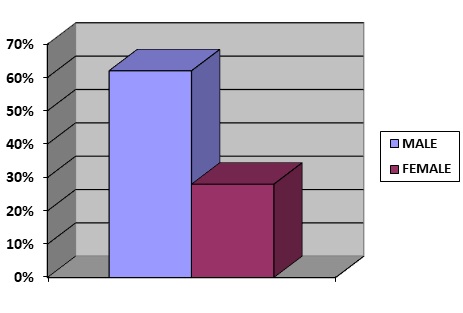A descriptive study on the hypertensive crisis in Visakhapatnam, Andhra Pradesh, India
Abstract
Objective: The objective of the present study, A Descriptive study on Hypertensive Crisis in Visakhapatnam, India was to evaluate the modes of presentations, clinical profile, and spectrum of target organ damage in patients with hypertensive emergencies.
Material and Methods: The study population included patients admitted in this hospital with severely elevated blood pressure with clinical or laboratory evidence of acute target organ damage.
Result: The clinical and laboratory profile of 50 of these patients were evaluated. Males had higher chances of developing a hypertensive emergency compared to females. The commonest presenting symptoms were chest pain, dyspnoea, and neurological deficit. The majority of the patients have known hypertensives. Higher levels of blood pressure at presentation were associated with an adverse outcome. Acute LVF was the commonest target organ damage observed. In-hospital mortality of 14% was observed in the present study.
Conclusion: Known hypertensives are at a higher risk of presenting with acute target organ damage associated with chest pain. Acute LVF is the commonest form of target organ damage encountered in the present study.
Downloads
References
Zampaglione B, Pascale C, Marchisio M, Cavallo-Perin P. Hypertensive urgencies and emergencies: prevalence and clinical presentation. Hypertension. 1996;27(1):144-147. doi: 10.1161/01.hyp.27.1.144.
Sandberg K, Ji H. Sex differences in primary hypertension. Biol Sex Differ. 2012;3(1):1-21. doi: 10.1186/2042-6410-3-7.
Vitale C, Fini M, Speziale G, Chierchia S. Gender differences in the cardiovascular effects of sex hormones. Fundam Clin pharmacol. 2010;24(6):675-685. doi: 10.1111/j.1472-8206.2010.00817.x.
Nguyen QC, Tabor JW, Entzel PP, Lau Y, Suchindran C, Hussey JM, et al. Discordance in national estimates of hypertension among young adults. Epidemiology (Cambridge, Mass.). 2011;22(4):532-541. doi: 10.1097/EDE.0b013e31821c79d2.
Rafighdoust A, Mohammadzadeh Shabestari M, Bostani T. A Study of Hypertensive Crisis and Precipitating Factors. Iranian Heart J. 2006;7(4):31-36.
Martin JF, Higashiama É, Garcia E, Luizon MR, Cipullo JP. Hypertensive crisis profile. Prevalence and clinical presentation. Arq Bras Cardiol. 2004;83(2):131-136. doi: 10.1590/s0066-782x2004001400004.
Kaplan NM. Hypertensive crisis in Kaplan AM, ed. Clinical hypertension,11th edition. Lippincot Willams and Wilkins 2015.
Lip GY, Beevers M, Beevers DG. Complications and survival of 315 patients with malignant-phase hypertension. J Hypertens. 1995;13(8):915-924. doi: 10.1097/00004872-199508000-00013.
Salagre SB, Itolikar SM, Gedam K. A Prospective Observational Study to Determine the Prevalence and Clinical Profile of Patients of Hypertensive Crisis in a Tertiary Care Hospital. J Assoc Physicians India. 2017;65(6):14-21.
de Jager RL, de Beus E, Beeftink MM, Sanders MF, Vonken EJ, Voskuil M. et al. Impact of medication adherence on the effect of renal denervation: the SYMPATHY trial. Hypertension. 2017;69(4):678-684. doi: 10.1161/HYPERTENSIONAHA.116.08818.
Pierin AMG, Flórido CF, Santos J. Hypertensive crisis: clinical characteristics of patients with hypertensive urgency, emergency and pseudocrisis at a public emergency department. einstein (São Paulo). 2019;17(4):eAO4685. doi: 10.31744/einstein_journal/2019AO4685.
Shao PJ, Sawe HR, Murray BL, Mfinanga JA, Mwafongo V, Runyon MS. Profile of patients with hypertensive urgency and emergency presenting to an urban emergency department of a tertiary referral hospital in Tanzania. BMC Cardiovasc Disord. 2018;18(1):158. doi: 10.1186/s12872-018-0895-0.

Copyright (c) 2020 Author (s). Published by Siddharth Health Research and Social Welfare Society

This work is licensed under a Creative Commons Attribution 4.0 International License.


 OAI - Open Archives Initiative
OAI - Open Archives Initiative


